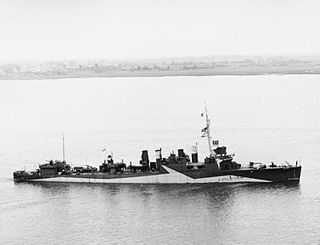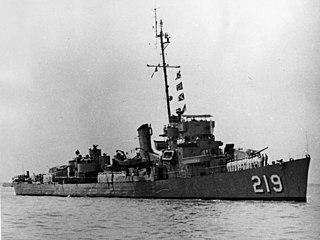
USS Goldsborough (DD-188/AVP-18/AVD-5/APD-32) was a Clemson-class destroyer in the United States Navy during World War II. She was the second Navy ship named for Rear Admiral Louis M. Goldsborough (1805–1877). Entering service in 1920, the ship had a brief active life before being placed in reserve in 1922. Goldsborough was reactivated for World War II and was used as an aircraft tender, destroyer and high speed transport in both Atlantic and Pacific theaters. Following the war, the ship was sold for scrapping in 1946.

USS Herndon (DD-198) was a Clemson-class destroyer in the United States Navy. Herndon served in the United States Coast Guard as CG-17. She was later transferred to the Royal Navy as HMS Churchill and still later to the Soviet Navy as Deyatelny.

USS Belknap (DD-251/AVD-8/DD-251/APD-34) was a Clemson-class destroyer in the United States Navy during World War II. She was named for Rear Admiral George Belknap.

USS Lloyd (DE-209/APD-63), a Buckley-class destroyer escort of the United States Navy, was named in honor of Ensign William R. Lloyd (1916–1942).

USS J. Douglas Blackwood (DE-219), was a Buckley-class destroyer escort in service with the United States Navy from 1943 to 1946 and from 1951 to 1961. She was sunk as a target in 1970.
USS Pigeon (AM-374) was an Auk-class minesweeper acquired by the United States Navy for the dangerous task of removing mines from minefields laid in the water to prevent ships from passing.

USS Menelaus (ARL-13) was laid down as a United States Navy LST-542-class tank landing ship but converted to one of 39 Achelous-class repair ships that were used for repairing landing craft during World War II. Named for Menelaus, she was the only US Naval vessel to bear the name.
USS Daedalus (ARL-35) was one of 39 Achelous-class landing craft repair ships built for the United States Navy during World War II. Named for Daedalus, she was the only U.S. Naval vessel to bear the name.
USS Heed (AM-100) was an Auk-class minesweeper built for the United States Navy during World War II. She earned five battle stars for her World War II service. She was recommissioned during the Korean War. She was placed in reserve in 1954 and remained there until struck from the Naval Vessel Register in 1967.

USS Sprig (AM-384) was an Auk-class minesweeper acquired by the United States Navy for the dangerous task of removing mines from minefields laid in the water to prevent ships from passing.
USS Pochard (AM-375) was an Auk-class minesweeper acquired by the United States Navy for the dangerous task of removing mines from minefields laid in the water to prevent ships from passing.

USS Baham (AK-122/AG-71) was a Basilan-class auxiliary ship, converted from a Liberty ship, commissioned by the United States Navy for service in World War II. She was first named after former Florida, resident Elizabeth C. Bellamy, the daughter of General William Croom, and wife of Doctor Samuel C. Bellamy. She was renamed and commissioned after Baham, a star in constellation Pegasus. She was responsible for delivering troops, goods and equipment to locations in the war zone.

USS Owl (AMCU-35) was a LCI(L)-351-class large landing craft of the United States Navy, later converted to an AMCU-7-class coastal minesweeper.
USS Catbird (AM-68) was the lead ship of her class of two naval trawlers, which were operated as minesweepers by the United States Navy during World War II.

USS Kirkpatrick (DE-318) was an Edsall-class destroyer escort built for the U.S. Navy during World War II. She served in the Atlantic Ocean the Pacific Ocean and provided destroyer escort protection against submarine and air attack for Navy vessels and convoys. Post-war, she was converted to a radar picket ship to support the DEW Line.
USS Method (AM-264) was an Admirable-class minesweeper built for the United States Navy during World War II and in commission from 1944 to 1945. In 1945, she was transferred to the Soviet Union and served in the Soviet Navy after that as T-276. The Soviets converted her into a whalecatcher in 1948 and renamed her Purga.
USS Nucleus (AM-268) was an Admirable-class minesweeper built for the United States Navy during World War II and in commission from 1943 to 1945. In 1945, she was transferred to the Soviet Union and after that served in the Soviet Navy as T-278. The Soviets converted her into a naval trawler in 1948 and renamed her Uragan.
USS Rampart (AM-282) was an Admirable-class minesweeper built for the United States Navy during World War II and in commission from 1944 to 1945. In 1945, she was transferred to the Soviet Union and after that served in the Soviet Navy as T-282. She was converted to a naval trawler in 1948 and renamed Shkval.

USS Odum (APD-71), ex-DE-670, was a United States Navy high-speed transport in commission from 1945 to 1946.

USS Pavlic (APD-70) was built by Dravo Corporation at Pittsburgh, Pennsylvania as a Buckley-class destroyer escort. Pavlic was launched 18 December 1943 and towed to Texas for refitting as a United States Navy high-speed transport. Pavlic was in commission from 1944 to 1946, serving in the Okinawa campaign as a radar picket ship. Pavlic was decommissioned 15 November 1946. After more than 20 years of inactivity in reserve, she was stricken from the Navy List on 1 April 1967. On 1 July 1968, she was sold for scrapping to North American Smelting Company.











